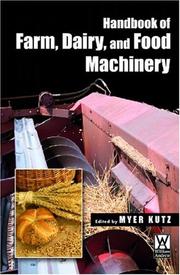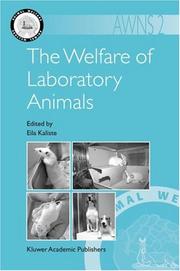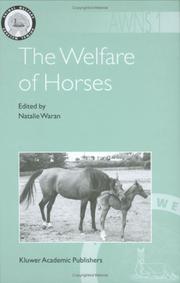| Listing 1 - 6 of 6 |
Sort by
|
Book
ISBN: 3788070528 3788070560 3788070714 Year: 1974 Publisher: Karlsruhe : C.F. Müller,
Abstract | Keywords | Export | Availability | Bookmark
 Loading...
Loading...Choose an application
- Reference Manager
- EndNote
- RefWorks (Direct export to RefWorks)
697.9 --- 631.2 --- 631.2 Farm buildings, structures and installations. Buildings for livestock, produce, machinery and equipment --- Farm buildings, structures and installations. Buildings for livestock, produce, machinery and equipment --- 697.9 Ventilation. Air conditioning --- Ventilation. Air conditioning --- Air conditioning --- Climatisation
Book
ISBN: 9789048131341 9048131340 9048131359 9789048131358 9789048131365 9789400791831 9400791836 9786613001641 1283001640 Year: 2010 Publisher: Dordrecht Springer Netherlands
Abstract | Keywords | Export | Availability | Bookmark
 Loading...
Loading...Choose an application
- Reference Manager
- EndNote
- RefWorks (Direct export to RefWorks)
Prenatal life is the period of maximal development in animals, and it is well recognised that factors that alter development can have profound effects on the embryonic, fetal and postnatal animal. Scientists involved in research on livestock productivity have for decades studied postnatal consequences of fetal development on productivity. Recently, however, there has been a surge in interest in how to manage prenatal development to enhance livestock health and productivity. This has occurred largely due to the studies that show human health in later life can be influenced by events during prenatal life, and establishment of the Fetal Origins and the Thrifty Phenotype Hypotheses. This book, Managing the Prenatal Environment to Enhance Livestock Productivity reviews phenotypic consequences of prenatal development, and provides details of mechanisms that underpin these effects in ruminants, pigs and poultry. The chapters have been divided into three parts: Quantification of prenatal effects on postnatal productivity, mechanistic bases of postnatal consequences of prenatal development and regulators of fetal and neonatal nutrient supply. Managing the Prenatal Environment to Enhance Livestock Productivity is a reference from which future research to improve the level of understanding and capacity to enhance productivity, health and efficiency of livestock in developing and developed countries will evolve. It is particularly timely given the development of molecular technologies that are providing new insight into regulation and consequences of growth and development of the embryo, fetus and neonate.
Physiology: reproduction & development. Ages of life --- Gynaecology. Obstetrics --- Veterinary medicine --- foetus --- vroedkunde --- Developing countries --- Animal genetics. --- Medicine. --- Life sciences. --- Animal Genetics and Genomics. --- Biomedicine, general. --- Life Sciences, general. --- Biosciences --- Sciences, Life --- Science --- Health Workforce --- Genetics --- Livestock --- Livestock productivity. --- Prenatal influences. --- Breeding.
Book

ISBN: 9789086861347 9789086861682 9086861687 9086861342 Year: 2012 Publisher: Wageningen Wageningen Academic Publishers
Abstract | Keywords | Export | Availability | Bookmark
 Loading...
Loading...Choose an application
- Reference Manager
- EndNote
- RefWorks (Direct export to RefWorks)
This book assesses the institutional, technical and market constraints as well as opportunities for smallholders, notably, emerging farmers in disadvantaged areas such as the former homelands of South Africa. Emerging farmers are previously disadvantaged black people who started or will start their business with the support of special government programs. Public support programs have been developed as part of the Black Economic Empowerment strategy of the South African government. These programs aim to improve the performance of emerging farmers. This requires, first and foremost, upgrading the emerging farmers skills by providing access to knowledge about agricultural and entrepreneurial practices. To become or to remain good farmers they also need access to suitable agricultural land and sufficient water for irrigation and for feeding their cattle. Finally, for emerging farmers to be engaged in viable farming operations, various factors need to be in place such as marketing and service institutions to give credit for agricultural inputs and investments; input markets for farm machinery, farm implements, fertilizers and quality seeds; and accessible output markets for their end products. This book develops a policy framework and potential institutional responses to unlock the relevant markets for smallholders.
Economic conditions. Economic development --- Trade theory --- Developing countries: agricultural and food problems --- Biology --- biologie --- South Africa --- Life sciences. --- Life Sciences, general. --- Biosciences --- Sciences, Life --- Science --- governance in supply --- smallholder farmers --- strategies to improve market access --- unlocking markets --- institutional and technical constraints --- Livestock --- Supermarket --- Economics --- Small-scale forestry

ISBN: 9780815515388 3540211179 9783540336556 9783540211174 9786612923852 3540336559 1282923854 9781601194084 1601194080 0815515383 9780815517504 0815517505 1282253174 9781282253179 6612002654 9786612002656 0080947344 9780080947341 0815517513 9780815517511 Year: 2006 Publisher: Norwich, NY : Heidelberg, Germany : W. Andrew Pub. ; Springer,
Abstract | Keywords | Export | Availability | Bookmark
 Loading...
Loading...Choose an application
- Reference Manager
- EndNote
- RefWorks (Direct export to RefWorks)
MEMS are rapidly moving from the research laboratory to the mar ketplace. Many market studies indicate not only a tremendous market potential of MEMS devices; year by year we see the actual market grow as the technology matures. In fact, these days, many large silicon foundries have a MEMS group exploring this promising technology, including such giants as INTEL and Motorola. Yet MEMS are fundamentally different from microelectronics. This means that companies with an established track record in these branches need to adapt their skills, whereas companies that want to enter the "miniaturization" market need to establish an entirely new set of capabil ities. The same can be said of engineers with classical training, who will also need to be educated toward their future professional activity in the MEMS field. Here are some questions that a company or technologist may ask: I have an existing product with miniaturization market poten tial. Which technology should I adopt? What are the manufacturing options available for miniaturiza tion? What are the qualitative differences? How do we maintainamarketleadforproductsbased onMEMS? Is there CAD support?Can we outsource manufacturing? Which skills in our current capability need only adaptation? What skills need to be added? Professors Jan Korvink and Oliver Paul have set out to answer these questions in a form that addresses the needs of companies, commercial practitioners, and technologists.
631.2 --- 637.1 --- 637.1 Dairying and dairy produce in general --- Dairying and dairy produce in general --- 631.2 Farm buildings, structures and installations. Buildings for livestock, produce, machinery and equipment --- Farm buildings, structures and installations. Buildings for livestock, produce, machinery and equipment --- Microwaves, RF and Optical Engineering. --- Micro-ondes --- Accelerometers. --- Engineering. --- Microwaves. --- Optical engineering. --- Electronics. --- Microelectronics. --- Optical materials. --- Electronic materials. --- Nanotechnology. --- Electronics and Microelectronics, Instrumentation. --- Optical and Electronic Materials. --- Molecular technology --- Nanoscale technology --- High technology --- Electronic materials --- Optics --- Materials --- Microminiature electronic equipment --- Microminiaturization (Electronics) --- Electronics --- Microtechnology --- Semiconductors --- Miniature electronic equipment --- Electrical engineering --- Physical sciences --- Mechanical engineering --- Hertzian waves --- Electric waves --- Electromagnetic waves --- Geomagnetic micropulsations --- Radio waves --- Shortwave radio --- Construction --- Industrial arts --- Technology --- Microelectromechanical systems.

ISBN: 9781402022708 1402022700 9781402022715 9781402061363 1402061366 9786610852390 1280852399 1402022719 Year: 2004 Volume: 2 Publisher: Dordrecht ; Boston : Kluwer Academic Publishers,
Abstract | Keywords | Export | Availability | Bookmark
 Loading...
Loading...Choose an application
- Reference Manager
- EndNote
- RefWorks (Direct export to RefWorks)
Animal welfare is attracting increasing interest worldwide, but particularly from those in developed countries, who now have the knowledge and resources to be able to offer the b est management systems for their farm animals, as well as potentially being able to offer plentiful resources for companion, zoo and laboratory animals. The increased attention given to animal welfare in the West derives la rgely from the fact that the relentless pursuit of financial reward and efficiency has lead to the development of intensive animal production systems that offend the conscience of many consumers in those countries. In devel oping countries, human survival is still a daily uncertainty, so that provision fo r animal welfare has to be balanced against human welfare. Welfare is usua lly provided for only if it supports the output of the animal, be it food, work, clothing, sport or companionship. In reality there are resources for all if they are properly husbanded in both developing and developed countries. The inequitable division of the world’s riches creates physical and psychological poverty for humans and animals alike in all sectors of the world. Liv estock are the world’s biggest land user (FAO, 2002) and the population, particularly of monogastric animals, is increasing rapidly to meet the need of an expanding human population. Populations of animals managed by humans are therefore increasing worldwide, so there is the tendency to allocate fewer resources to each one.
Animal Welfare. --- Animals, Laboratory. --- Animal welfare. --- Laboratory animals. --- Animaux --- Animaux de laboratoire --- Protection --- Agriculture. --- Laboratory animals --- Animal welfare --- Animal Welfare --- Animals, Laboratory --- Animal Population Groups --- Social Control, Formal --- Sociology --- Animals --- Social Sciences --- Eukaryota --- Anthropology, Education, Sociology and Social Phenomena --- Organisms --- Zoology - General --- Social Welfare & Social Work - General --- Animal Sciences --- Zoology --- Agriculture --- Social Welfare & Social Work --- Health & Biological Sciences --- Earth & Environmental Sciences --- Animals, Experimental --- Animals in research --- Experimental animals --- Lab animals --- Animal culture --- Laboratory organisms --- Working animals --- Animal experimentation --- Abuse of animals --- Animal cruelty --- Animals, Cruelty to --- Animals, Protection of --- Animals, Treatment of --- Cruelty to animals --- Humane treatment of animals --- Kindness to animals --- Mistreatment of animals --- Neglect of animals --- Prevention of cruelty to animals --- Protection of animals --- Treatment of animals --- Welfare, Animal --- Abuse of --- Social aspects --- Zoology. --- Animal genetics. --- Animal behavior. --- Animal physiology. --- Veterinary medicine. --- Animal Genetics and Genomics. --- Behavioral Sciences. --- Animal Physiology. --- Veterinary Medicine/Veterinary Science. --- Farriery --- Large animal medicine --- Large animal veterinary medicine --- Livestock medicine --- Veterinary science --- Medicine --- Animal health --- Domestic animals --- Livestock --- Animal physiology --- Biology --- Anatomy --- Animals, Habits and behavior of --- Behavior, Animal --- Ethology --- Animal psychology --- Ethologists --- Psychology, Comparative --- Genetics --- Natural history --- Diseases --- Losses --- Physiology --- Behavior --- Behavioral sciences. --- Animal Husbandry. --- Dogs. --- Rabbits. --- Animal Husbandry --- Dogs --- Rabbits --- Primates --- Rodents --- Swine

ISBN: 9781402007668 1402007663 9780306482151 1402061420 0306482150 1280957840 Year: 2002 Publisher: Dordrecht ; Boston : Kluwer Academic Publishers,
Abstract | Keywords | Export | Availability | Bookmark
 Loading...
Loading...Choose an application
- Reference Manager
- EndNote
- RefWorks (Direct export to RefWorks)
Animal welfare is attracting increasing interest worldwide, but particularly from those in developed countries, who now have the knowledge and resources to be able to offer the best management systems for their farm animals, as well as potentially being able to offer plentiful resources for companion, zoo and laboratory animals. The increased attention given to farm animal welfare in the West derives largely from the fact that the relentless pursuit of financial reward and efficiency has led to the development of intensive animal production systems, that challenge the conscience of many consumers in those countries. In developing countries human survival is still a daily uncertainty, so that provision for animal welfare has to be balanced against human welfare. Welfare is usually provided for only if it supports the output of the animal, be it food, work, clothing, sport or companionship. In reality, there are resources for all if they are properly husbanded in both developing and developed countries. The inequitable division of the world’s riches creates physical and psychological poverty for humans and animals alike in all sectors of the world. Livestock are the world’s biggest land user (FAO, 2002) and the population is increasing rapidly to meet the need of an expanding human population. Populations of farm animals managed by humans are therefore increasing worldwide, and there is the tendency to allocate fewer resources to each animal. Increased attention to welfare issues is just as evident for companion, laboratory, wild and zoo animals.
Horses. --- Animal welfare. --- Chevaux --- Animaux --- Protection --- Agriculture. --- Horses --- Animal welfare --- Recreation & Sports --- Zoology - General --- Zoology --- Social Sciences --- Health & Biological Sciences --- 633.5 --- Paarden (lt) --- Veterinary medicine --- Abuse of animals --- Animal cruelty --- Animals --- Animals, Cruelty to --- Animals, Protection of --- Animals, Treatment of --- Cruelty to animals --- Humane treatment of animals --- Kindness to animals --- Mistreatment of animals --- Neglect of animals --- Prevention of cruelty to animals --- Protection of animals --- Treatment of animals --- Welfare, Animal --- Equus caballus --- Farriery --- Hippology --- Horse --- Domestic animals --- Equus --- Livestock --- Pachyderms --- Hinnies --- Mules --- Abuse of --- Social aspects --- Zoology. --- Animal genetics. --- Animal physiology. --- Animal behavior. --- Animal Genetics and Genomics. --- Animal Physiology. --- Behavioral Sciences. --- Animals, Habits and behavior of --- Behavior, Animal --- Ethology --- Animal psychology --- Ethologists --- Psychology, Comparative --- Animal physiology --- Biology --- Anatomy --- Genetics --- Natural history --- Behavior --- Physiology --- Behavioral sciences.
| Listing 1 - 6 of 6 |
Sort by
|

 Search
Search Feedback
Feedback About UniCat
About UniCat  Help
Help News
News